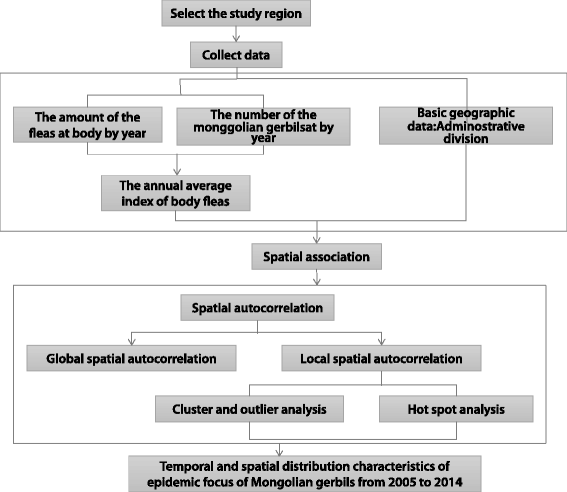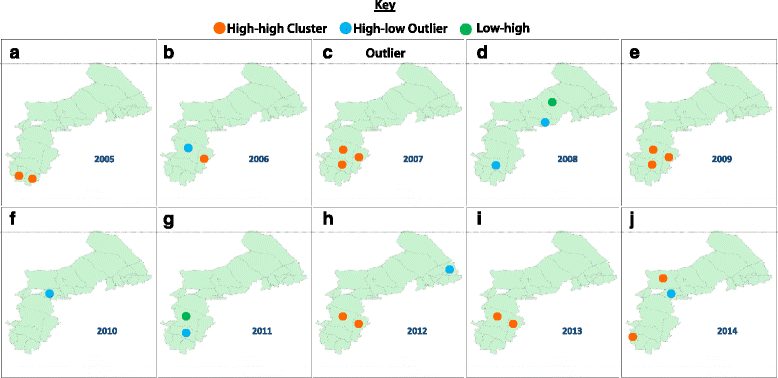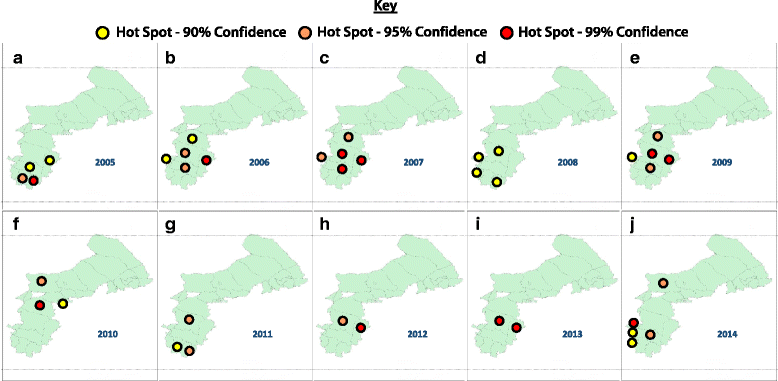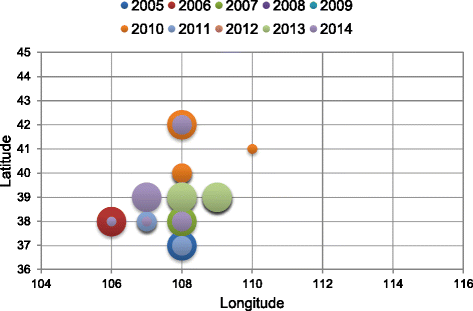Temporal and spatial distribution characteristics in the natural plague foci of Chinese Mongolian gerbils based on spatial autocorrelation
- PMID: 28780908
- PMCID: PMC5545858
- DOI: 10.1186/s40249-017-0338-7
Temporal and spatial distribution characteristics in the natural plague foci of Chinese Mongolian gerbils based on spatial autocorrelation
Abstract
Background: The nest flea index of Meriones unguiculatus is a critical indicator for the prevention and control of plague, which can be used not only to detect the spatial and temporal distributions of Meriones unguiculatus, but also to reveal its cluster rule. This research detected the temporal and spatial distribution characteristics of the plague natural foci of Mongolian gerbils by body flea index from 2005 to 2014, in order to predict plague outbreaks.
Methods: Global spatial autocorrelation was used to describe the entire spatial distribution pattern of the body flea index in the natural plague foci of typical Chinese Mongolian gerbils. Cluster and outlier analysis and hot spot analysis were also used to detect the intensity of clusters based on geographic information system methods. The quantity of M. unguiculatus nest fleas in the sentinel surveillance sites from 2005 to 2014 and host density data of the study area from 2005 to 2010 used in this study were provided by Chinese Center for Disease Control and Prevention.
Results: The epidemic focus regions of the Mongolian gerbils remain the same as the hot spot regions relating to the body flea index. High clustering areas possess a similar pattern as the distribution pattern of the body flea index indicating that the transmission risk of plague is relatively high. In terms of time series, the area of the epidemic focus gradually increased from 2005 to 2007, declined rapidly in 2008 and 2009, and then decreased slowly and began trending towards stability from 2009 to 2014. For the spatial change, the epidemic focus regions began moving northward from the southwest epidemic focus of the Mongolian gerbils from 2005 to 2007, and then moved from north to south in 2007 and 2008.
Conclusions: The body flea index of Chinese gerbil foci reveals significant spatial and temporal aggregation characteristics through the employing of spatial autocorrelation. The diversity of temporary and spatial distribution is mainly affected by seasonal variation, the human activity and natural factors.
Keywords: Body fleas; China; Geographic information system; Moran’s I; Plague natural focus of Mongolian gerbils; Spatial autocorrelation; Temporal and spatial distribution.
Conflict of interest statement
Ethics approval and consent to participate
The study protocol was approved; written informed consent had also been obtained by the Ethics Review Committee. No specific permits were required for the field studies focusing on the Mongolian gerbils’ body fleas, as they did not involve endangered or protected species.
Consent for publication
Not applicable.
Competing interests
The authors declare that they have no competing interests.
Figures






References
-
- Li ZL, Chen D. Studies on relationships among parasitic flea index of Meriones unguiculatus and meteorological factors. Acta Entomol Sin. 1999;42(3):284–290.
MeSH terms
LinkOut - more resources
Full Text Sources
Other Literature Sources
Medical

